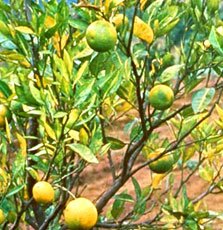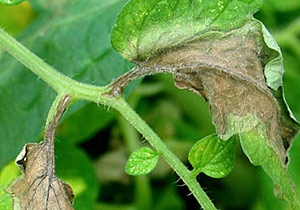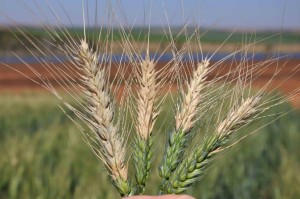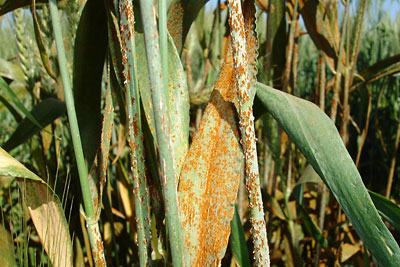|
|
Plants get sick, and not just in the distant past. Plant diseases continue to cause major economic loss to growers, increased prices for consumers, and in many parts of the world, loss of food security. Some examples of plant diseases that are now or have recently been covered in the popular media are described below.
 Photo: H.D. Catling Bugwood.org
Photo: H.D. Catling Bugwood.org |
"Yellow Dragon Disease" of Citrus
Oranges, grapefruits, lemon, limes – in fact, all the citrus you eat is under attack from a disease called citrus greening or Huanglongbing (that's Chinese for Yellow Dragon Disease). Citrus greening is caused by a bacterium called Liberibacter asiaticus. L. asiaticus is moved from plant to plant by an insect called the Asian citrus psyllid so it can spread very quickly through citrus growing regions. As of 2014 all of the major citrus growing regions in Florida are infected and the disease has cost the industry billions of dollars and thousands of jobs.. |
| Control: Spraying insecticides and removing infected trees can help slow the spread of this disease, but there are currently no effective long term means for disease control. Unlike plant-pathogen interactions like P. syringae and tomato, very little is known about how gene products from L. asiaticus establish infection and interact with plant defense pathways in the citrus plants. |
Learn more:
On NBC News (video): Florida citrus greening decimates crops
In the New York Times: A race to save the orange by altering its DNA
(includes discussion of using resistance genes from spinach to engineer resistant citrus trees)
APS Feature Article: Citrus Greening - The Yellow Dragon Threatens Florida Citrus
|
 Photo: Meg McGrath,Cornell University
Photo: Meg McGrath,Cornell University |
The 2009 Late Blight Epidemic
When you say "late blight" most people think of the Irish Potato Famine that occured during the 1840's, but Phytophthera infestans, the causal agent of this disease, is still with us and can be a source of major crop losses. In 2009, the eastern United States had a cool wet summer, conditions which favor this disease. Infection of tomatoes and related plants led to dramatic crop losses for commercial growers and gardeners. |
| Control: Strategies for controlling late light include planting resistant cultivars, use of fungicides that kill the pathogen, and destruction of infected plant material to reduce spread of the pathogen |
Learn more:
In the New York Times: Northeast Tomatoes Lost, and Potatoes May Follow
APS Feature Article: The 2009 Late Blight Pandemic in Eastern USA
Even Martha Stewart commented! The Tomato Blight in my Garden
|

Diseased wheat spikes carry shriveled or no grain at all. Photo: CIMMYT
|
Wheat Blast
Wheat blast is caused by the fungus Magneporthe oryzae. This disease was first identified in Brazil in 1985 where it has significantly limited wheat production. In early 2016 there was an outbreak of wheat blast in Bangladesh where wheat is an important staple crop. Further spread of the disease could be devastating to wordl wheat production because there is little genetic resistance and fungicides have not been effective for control. |
| Control: Some wheat cultivars have been identified that are tolerant but the varieties grown in Bangladesh and other warm, humid regions have little or no resistance. More research is also needed on safe and effective chemical control. |
Learn more:
CIMMYT: Information page on Wheat Blast
The Atlantic: The Wheat Disease Threatening Asia's Food Supply
Scientific American: Devastating Wheat Fungus Appears in Asia for the First Time
|
 Photo: R. Coffman, Cornell University
Photo: R. Coffman, Cornell University |
Wheat Stem Rust Ug99
Rust disease on cereal crops is caused by the fungus Puccinia graminus In 1999 a race of this fungus, Ug99, was found in Uganda. Wheat is a very important crop in many parts of the world and as Ug99 spreads across Asia, Africa, and Middle East, researchers are racing to develop wheat strains that are resistant to Ug99 and that can grow in these very different environments. |
| Control: Fungicides can be used to kill the pathogen but they are far too expensive for growers in many parts of the world. The Borlaug Global Rust Initiative was organized in 2008 with the goal of coordinating activities of research leaders around to world to identify resistance genes effective against Ug99 and incorporate them into what strains favored in different parts of the world. |
Learn more:
LA Times: A 'time bomb' for world wheat crop
WIRED Magazine: Red Menace: Stop the Ug99 Fungus before its Spores bring Starvation
Pulitzer Center (video): Ug99 Wheat Rust Threatens World Wheat Crop
APS Feature Article: Stem Rust of Wheat
|
|
 |

